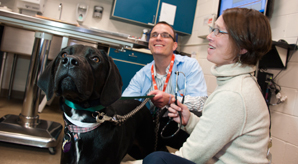Community Practice
Preparing for a New Dog in Your Home
Your new dog or puppy will need some time to adjust to his new home. Following are a few easy tips to ensure that he is safe and comfortable in his new surroundings.
- An enthusiastic or nervous dog or puppy may inadvertently bump into furniture or jump against surfaces as they explore a new space. Move breakable items out of harms way.
- Be mindful of household hazards and remove any hazardous items. Lock up or store cleaners and chemicals such as antifreeze, engine oil, and soaps out of reach of your new friend.
- Some plants are toxic to your pet. Move houseplants out of reach.
- Dogs find garbage cans very interesting, but ingesting garbage can be hazardous to their health. Make sure all garbage cans have secure lids and cannot be easily knocked over.
- Dogs and puppies enjoy playing with toys. Make sure children’s toys are out of reach, particularly toys with small parts that can easily be swallowed.
- Keep your dog away from ponds, pools, and hot tubs, or cover them so that your dog can’t fall in.
- Make sure your yard is secure. Walk around the perimeter of your yard and look for places where a dog could easily escape.
- Consider giving your dog his own room or corner of the house while he adjusts to his new surroundings. Place a dog crate in the room with the door open.
- If there are other dogs in the house, the introduction of a new dog should be a slow one. The initial meeting should be supervised and only for a short time.
- Designate an area of your yard as the dog’s bathroom. Take him to the same spot for each break, and remember that dogs may need frequent breaks. Puppies will need a break every few hours and right after he eats, drinks, wakes up from a nap or has been playing. Don’t punish your dog for accidents; instead, praise him when he takes his break in the right spot.
The CSU Veterinary Teaching Hospital provides comprehensive veterinary care. To make an appointment, call 970-297-500 or visit csuvets.colostate.edu

